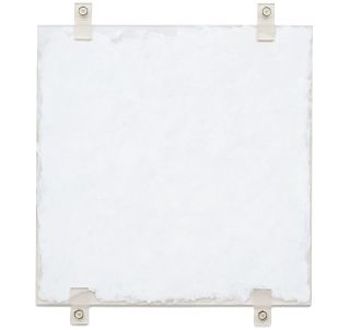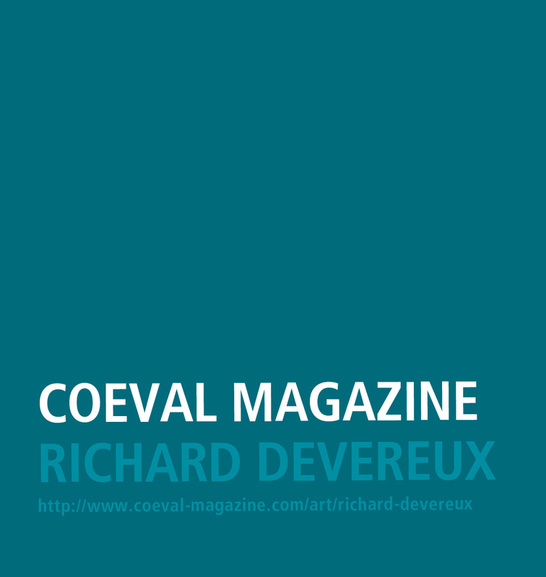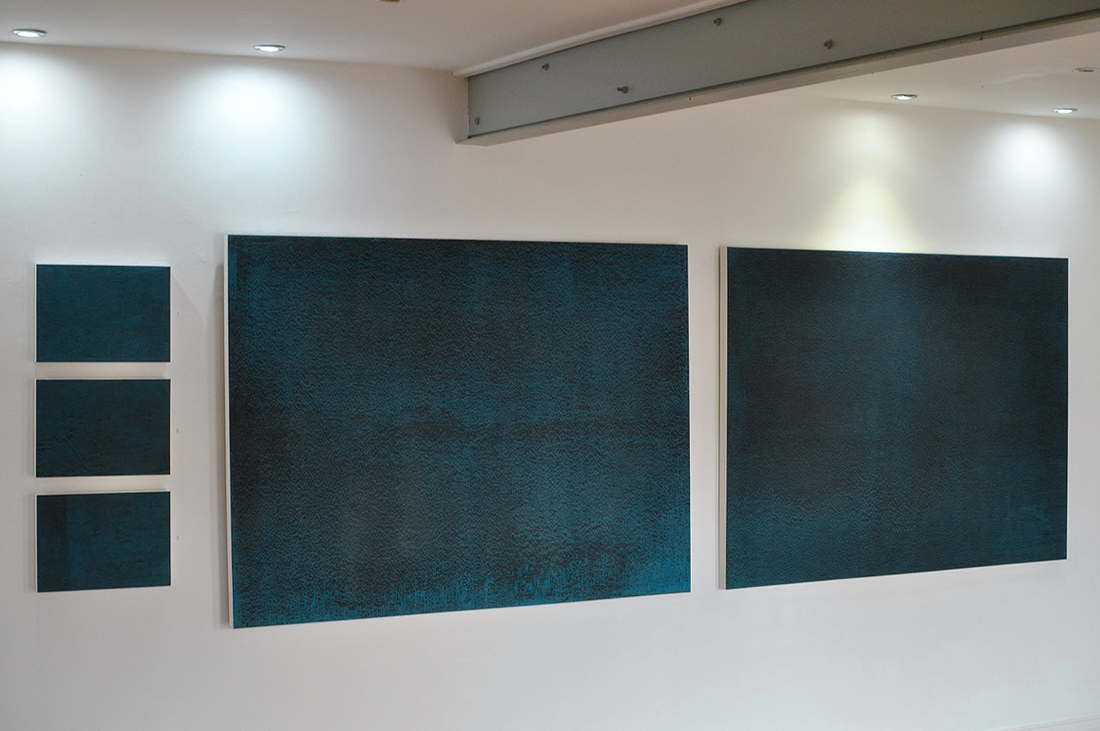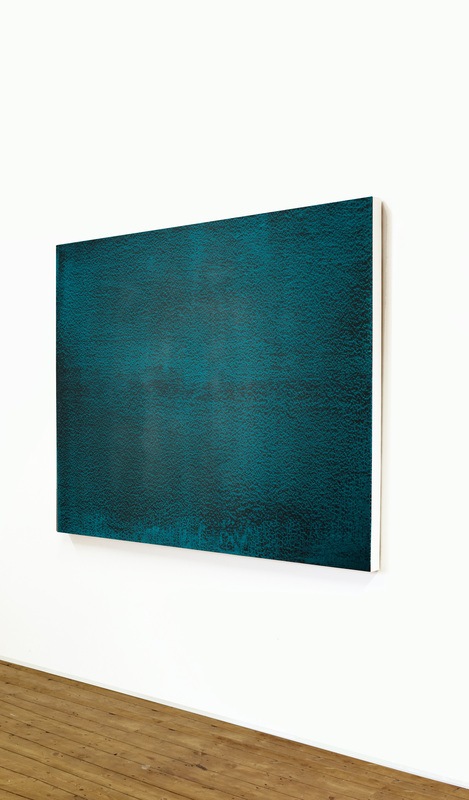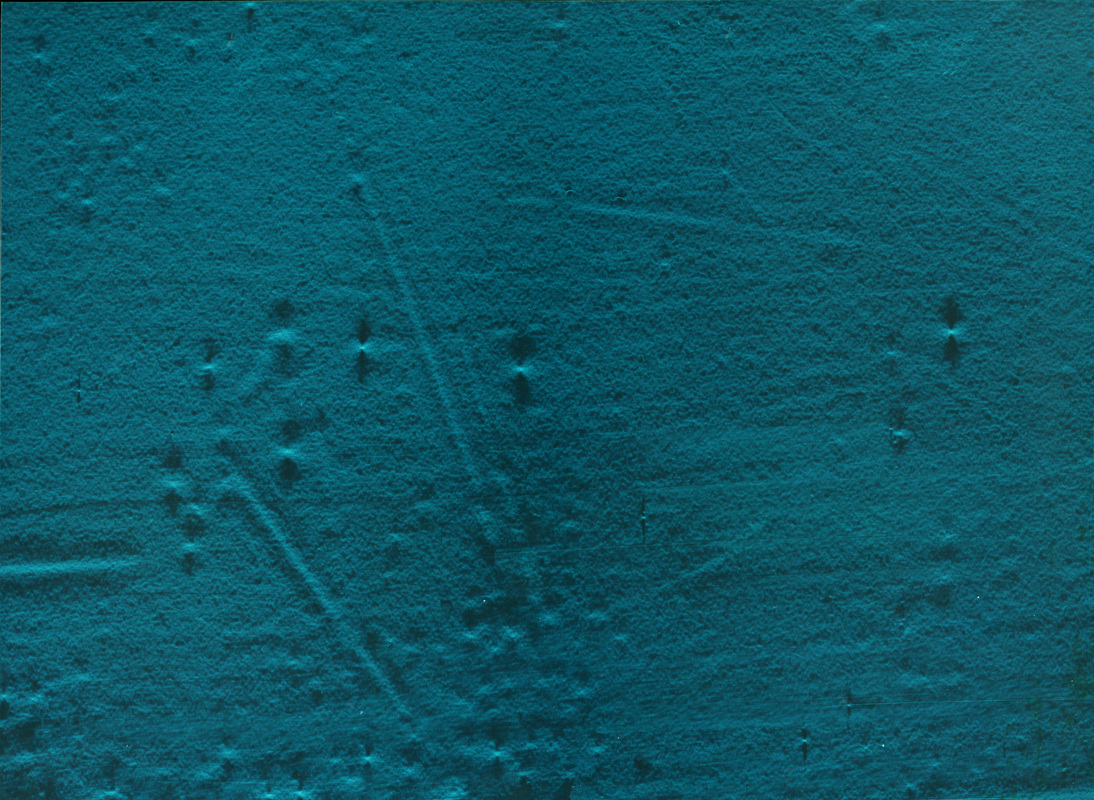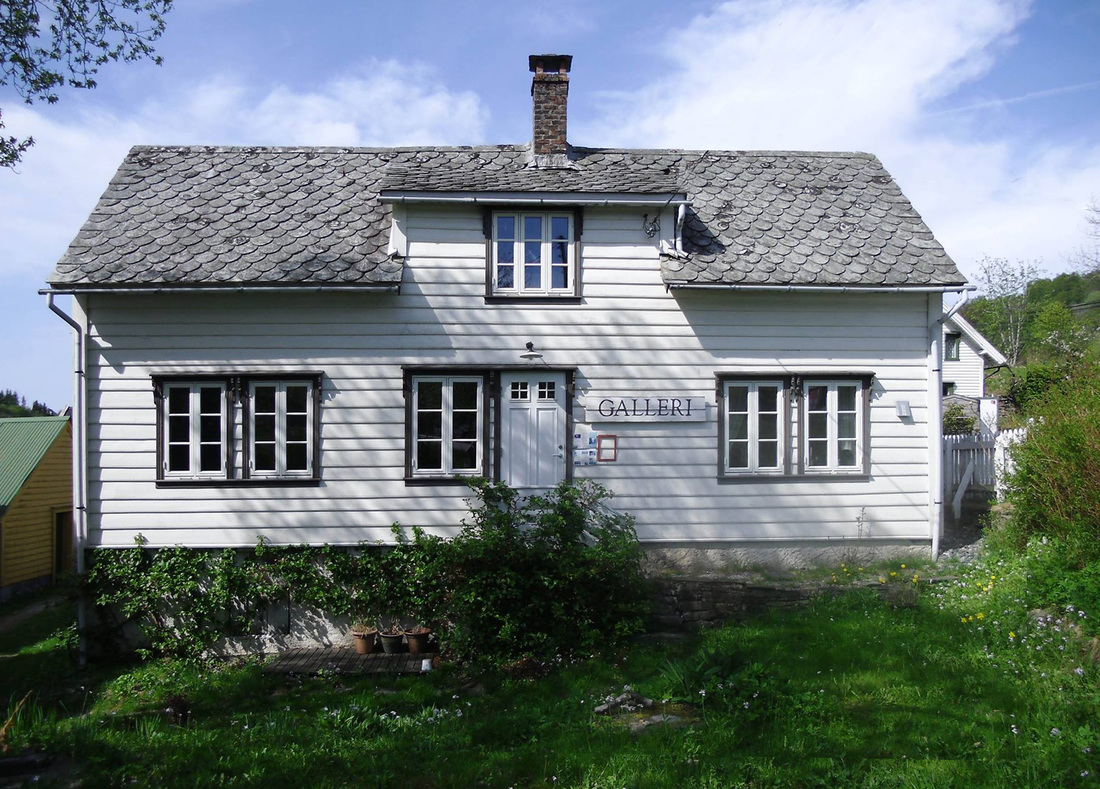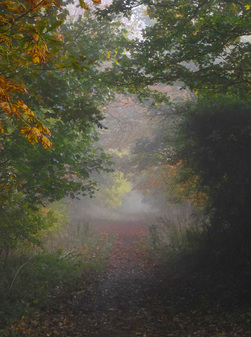
Richard Devereux lives in Lincoln, UK.
Born in 1956 he attended Portsmouth College of Art, UK between 1974-77. In 2002 he spent a brief period in Japan under the guidance of Zen Calligraphy Master, Terayama Tanchu Sensei.
He has maintained a working studio in the City of Lincoln for 36 years
richarddevereux.co.uk
31 January 2016 (final post)
Farewell Reside Residency, it has been a joy. The UK based printmaker/lithographer Serena Smith picks up the baton. image: © Hannah Devereux
14 January 2016
Rare footage of a 1998 BBC film where David Bowie discusses Richard Devereux’s work:
In Stillness and In Silence.
In Stillness and In Silence.
05 January 2016
Humans who spend time in the wilderness, alone, without man-made mechanical noise around them, often discover that their brain begins to recover its ability to discern things. (Robert Anderson)
17 December 2015
Robert Ryman
December 9, 2015 - June 18, 2016
545 West 22nd Street, New York City
08 December 2015
COEVAL MAGAZINE work by Richard Devereux
Monographic visual stories through experimental imaginary.
http://www.facebook.com/CoevalMagazine
http://www.coeval-magazine.com/art/richard-devereux
http://instagram.com/coevalmagazine/
http://coeval-magazine.tumblr.com/
COEVAL MAGAZINE work by Richard Devereux
Monographic visual stories through experimental imaginary.
http://www.facebook.com/CoevalMagazine
http://www.coeval-magazine.com/art/richard-devereux
http://instagram.com/coevalmagazine/
http://coeval-magazine.tumblr.com/
THIS IS NOW – turquoise (III) 2010, pigment dispersal on 100% cotton fibre, 108.5 x 72.5 cm
03 December 2015
Advice from Richard Serra:
Clear away the clutter and do your own thing
Richard Serra describes how academic art making, and traditional techniques, can be limiting, and reveals that the most influential artists all invented their own techniques.
A short film from SFMOMA
Advice from Richard Serra:
Clear away the clutter and do your own thing
Richard Serra describes how academic art making, and traditional techniques, can be limiting, and reveals that the most influential artists all invented their own techniques.
A short film from SFMOMA
RICHARD SERRA Double Rift #5, 2012, Paintstick on handmade paper
289.6 x 537.2 cm
289.6 x 537.2 cm
19 November 2015
Agnes Martin Her Life and Art Nancy Princenthal
Over the course of a career that spanned fifty years, Agnes Martin’s austere, serene work anticipated and helped to define Minimalism, even as she battled psychological crises and carved out a solitary existence in the American Southwest. Martin identified with the Abstract Expressionists but her commitment to linear geometry caused her to be associated in turn with Minimalist, feminist, and even outsider artists. She moved through some of the liveliest art communities of her time while maintaining a legendary reserve. “I paint with my back to the world,” she says both at the beginning and at the conclusion of a documentary filmed when she was in her late eighties. When she died at ninety-two, in Taos, New Mexico, it is said she had not read a newspaper in half a century. No substantial critical monograph exists on this acclaimed artist—the recipient of two career retrospectives as well as the National Medal of the Arts—who was championed by critics as diverse in their approaches as Lucy Lippard, Lawrence Alloway, and Rosalind Krauss. Furthermore, no attempt has been made to describe her extraordinary life. The whole engrossing story, told here for the first time,Agnes Martin is essential reading for anyone interested in abstract art or the history of women artists in America.
14 November 2015
CONTINUOUS NOW RICHARD DEVEREUX
TARPEY GALLERY 77 HIGH STREET, CASTLE DONINGTON DE74 2PQ UK
until 20th December, Thursday to Sunday 10.00–17.00
[email protected]
TARPEY GALLERY 77 HIGH STREET, CASTLE DONINGTON DE74 2PQ UK
until 20th December, Thursday to Sunday 10.00–17.00
[email protected]
13 November 2015
OTHER PLACES (III), 2015, pigment dispersal on panel, 25.5 x 17.0 x 3.8 cm
11 November 2015
Yale School of Art exhibition examines impact of Josef Albers’ art and teaching
By Amy Athey McDonald
Josef Albers, "Variant/Adobe, Browns, Ochre, Yellow," 1948, oil on masonite, 18 x 24 in., 1976.1.1384, © 2015 The Josef and Anni Albers Foundation/ARSNY
The Yale School of Art will launch its 2015-2016 season with an exhibition exploring the integration of artist Josef Albers’ teaching and artistic methods. "Search Versus Re-Search: Josef Albers, Artist and Educator" will include 18 paintings, prints, drawings, and studies by Albers, chair of the school’s Department of Design from 1950 to 1958, alongside 60 student works from his classroom prompts, some of which have never been exhibited. The exhibition will also feature an original short film and documentary footage. “Search Versus Re-Search” will be on view Sept. 8–Nov. 28 at the School of Art’s 32 Edgewood Avenue Gallery.
Albers was a passionate artist and visionary educator. He transformed the teaching of art and design in the 20th century by asserting that the point of making of art is not the finished product, but the process — that art is not an object, art is an experience. At Yale he reimagined the curriculum by integrating painting, sculpture, graphic arts, and architecture undunder the common purpose of design. In his work and teaching, Albers emphasized simple, accessible materials and techniques to produce infinite visual and material results. By offering his students a series of visual riddles about form, structure, and color, Albers inspired in them a new way of seeing and understanding. His approach had a formative influence on innumerable artists and thinkers including Sheila Hicks, Robert Mangold, Richard Serra, Alexander Purves, William Bailey, Richard Lytle, Eva Hesse, and Karsten Harries.
Albers is known for his acclaimed 1963 volume, “Interaction of Color,” a compilation of student responses to his teaching prompts and a masterwork of both pedagogical and artistic method. (Yale Press published an award-winning iPad version in 2013, which will also be available to sample in the exhibition.) Lesser known is the extensive archive Albers kept of student exercises from his drawing and design courses. Together, the works document the depth and breadth of his disciplined, albeit dynamic, teaching style.
Born in Germany, Albers studied and taught at the experimental Bauhaus in Weimar, Dessau, and Berlin. When the Bauhaus closed under Nazi pressure in 1933, many of its artists fled the country as refugees. That year, Albers and his wife, artist Anni Albers, were invited to teach at the newly formed Black Mountain College in North Carolina. Ultimately, the couple moved to Connecticut in 1950, when he took up his position at Yale. Albers was a prolific artist who worked in media as diverse as painting, printmaking, drawing, photography, glass, and furniture design, all the while establishing his reputation as an unparalleled educator.
The title for the exhibition is taken from a 1969 essay by Albers, in which he asks, "Why did the masters become masters? Because they tried to say something other than their masters had, not only different and new, but alive and ahead. Therefore they chose to follow themselves and search, not re-search; to move forward rather than backward."
"This mantra, 'search, not re-search,' evokes Albers' faith in practice before theory in the artistic process," says exhibition curator Anoka Faruqee, director of graduate studies and associate professor of painting and printmaking at the Yale School of Art. "While some works in this exhibition might qualify as 'finished,' all of the works are remainders of experience, and provocations to today’s artists to continually revise and experiment."
The Yale School of Art will launch its 2015-2016 season with an exhibition exploring the integration of artist Josef Albers’ teaching and artistic methods. "Search Versus Re-Search: Josef Albers, Artist and Educator" will include 18 paintings, prints, drawings, and studies by Albers, chair of the school’s Department of Design from 1950 to 1958, alongside 60 student works from his classroom prompts, some of which have never been exhibited. The exhibition will also feature an original short film and documentary footage. “Search Versus Re-Search” will be on view Sept. 8–Nov. 28 at the School of Art’s 32 Edgewood Avenue Gallery.
Albers was a passionate artist and visionary educator. He transformed the teaching of art and design in the 20th century by asserting that the point of making of art is not the finished product, but the process — that art is not an object, art is an experience. At Yale he reimagined the curriculum by integrating painting, sculpture, graphic arts, and architecture undunder the common purpose of design. In his work and teaching, Albers emphasized simple, accessible materials and techniques to produce infinite visual and material results. By offering his students a series of visual riddles about form, structure, and color, Albers inspired in them a new way of seeing and understanding. His approach had a formative influence on innumerable artists and thinkers including Sheila Hicks, Robert Mangold, Richard Serra, Alexander Purves, William Bailey, Richard Lytle, Eva Hesse, and Karsten Harries.
Albers is known for his acclaimed 1963 volume, “Interaction of Color,” a compilation of student responses to his teaching prompts and a masterwork of both pedagogical and artistic method. (Yale Press published an award-winning iPad version in 2013, which will also be available to sample in the exhibition.) Lesser known is the extensive archive Albers kept of student exercises from his drawing and design courses. Together, the works document the depth and breadth of his disciplined, albeit dynamic, teaching style.
Born in Germany, Albers studied and taught at the experimental Bauhaus in Weimar, Dessau, and Berlin. When the Bauhaus closed under Nazi pressure in 1933, many of its artists fled the country as refugees. That year, Albers and his wife, artist Anni Albers, were invited to teach at the newly formed Black Mountain College in North Carolina. Ultimately, the couple moved to Connecticut in 1950, when he took up his position at Yale. Albers was a prolific artist who worked in media as diverse as painting, printmaking, drawing, photography, glass, and furniture design, all the while establishing his reputation as an unparalleled educator.
The title for the exhibition is taken from a 1969 essay by Albers, in which he asks, "Why did the masters become masters? Because they tried to say something other than their masters had, not only different and new, but alive and ahead. Therefore they chose to follow themselves and search, not re-search; to move forward rather than backward."
"This mantra, 'search, not re-search,' evokes Albers' faith in practice before theory in the artistic process," says exhibition curator Anoka Faruqee, director of graduate studies and associate professor of painting and printmaking at the Yale School of Art. "While some works in this exhibition might qualify as 'finished,' all of the works are remainders of experience, and provocations to today’s artists to continually revise and experiment."
12 November 2015
OTHER PLACES (IV), 2015, pigment dispersal on panel, 29.1 x 40.2 x 4.0 cm
07 November 2015
ONE MORNING WE’LL SLIP INTO A HARBOUR WE’VE NEVER KNOWN
(After Olav H. Hauge), 2015, aqueous polyester and pigment dispersal on panel
162.5 x 121.0 x 5.0 cm
03 November 2015
What It Really Takes to Be an Artist: Teresita Fernández
'For some inexplicable reason, we seem to believe most strongly not in the actual formal lessons, but rather in those details that get into our heads without our knowing exactly how they got there. Those pivotal lessons in our lives continue to work on us in subtle, subterranean ways.
This kind of amnesia is life’s built-in way of making sure you filter out what’s not very important. You graduate today after years of hard work, immersive years of learning, absorbing, processing, accumulating, cramming, finishing, focusing. There are no more reasons, really, to even make art unless you really truly want to. Of all you learned you probably don’t need to remember most of the technical or theoretical information, as that’s all easily accessible with a quick search. And what you will remember will have less to do with the past and more to do with how it triggers reactions for you in the present. Oddly enough, what we involuntarily do retain is meant to help us move forward. This forthcoming amnesia that awaits you is just another kind of graduation, another step in a lifetime of many graduations.'
Teresita Fernández
What It Really Takes to Be an Artist: Teresita Fernández
'For some inexplicable reason, we seem to believe most strongly not in the actual formal lessons, but rather in those details that get into our heads without our knowing exactly how they got there. Those pivotal lessons in our lives continue to work on us in subtle, subterranean ways.
This kind of amnesia is life’s built-in way of making sure you filter out what’s not very important. You graduate today after years of hard work, immersive years of learning, absorbing, processing, accumulating, cramming, finishing, focusing. There are no more reasons, really, to even make art unless you really truly want to. Of all you learned you probably don’t need to remember most of the technical or theoretical information, as that’s all easily accessible with a quick search. And what you will remember will have less to do with the past and more to do with how it triggers reactions for you in the present. Oddly enough, what we involuntarily do retain is meant to help us move forward. This forthcoming amnesia that awaits you is just another kind of graduation, another step in a lifetime of many graduations.'
Teresita Fernández
Blind Blue Landscape, 2009, Teresita Fernández
01 November 2015
Richard Devereux
OTHER PLACES (III) 2015, pigment dispersal on panel, 29.1 x 40.2 x 4.0 cm
OTHER PLACES (III) 2015, pigment dispersal on panel, 29.1 x 40.2 x 4.0 cm
25 October 2015
Richard Devereux
OTHER PLACES (II) 2015, aqueous polyester and pigment dispersal on panel, 29.1 x 40.2 cm
OTHER PLACES (II) 2015, aqueous polyester and pigment dispersal on panel, 29.1 x 40.2 cm
16 October 2015
Anne Truitt “Artists have no choice but to express their lives.”
I do not understand why I seem able to make what people call art. For many long years I struggled to learn how to do it, and I don’t even know why I struggled. Then, in 1961, at the age of forty, it became clear to me that I was doing work I respected within my own strictest standards. Furthermore, I found this work respected by those whose understanding of art I valued. My first, instinctive reaction to this new situation was, if I’m an artist, being an artist isn’t so fancy because it’s just me. But now, thirteen years later, there seems to be more to it than that. It isn’t “just me.” A simplistic attitude toward the course of my life no longer serves.
The “just me” reaction was, I think, an instinctive disavowal of the social role of the artist. A life-saving disavowal. I refused, and still refuse, the inflated definition of artists as special people with special prerogatives and special excuses. If artists embrace this view of themselves, they necessarily have to attend to its perpetuation. They have to live it out. Their time and energy are consumed for social purposes. Artists then make decisions in terms of a role defined by others, falling into their power and serving to illustrate their theories. The Renaissance focused this social attention on the artist’s individuality, and the focus persists today in a curious form that on the one hand inflates artists’ egoistic concept of themselves and on the other places them at the mercy of the social forces on which they become dependent. Artists can suffer terribly in this dilemma. It is taxing to think out and then maintain a view of one’s self that is realistic.
Anne Truitt “Artists have no choice but to express their lives.”
I do not understand why I seem able to make what people call art. For many long years I struggled to learn how to do it, and I don’t even know why I struggled. Then, in 1961, at the age of forty, it became clear to me that I was doing work I respected within my own strictest standards. Furthermore, I found this work respected by those whose understanding of art I valued. My first, instinctive reaction to this new situation was, if I’m an artist, being an artist isn’t so fancy because it’s just me. But now, thirteen years later, there seems to be more to it than that. It isn’t “just me.” A simplistic attitude toward the course of my life no longer serves.
The “just me” reaction was, I think, an instinctive disavowal of the social role of the artist. A life-saving disavowal. I refused, and still refuse, the inflated definition of artists as special people with special prerogatives and special excuses. If artists embrace this view of themselves, they necessarily have to attend to its perpetuation. They have to live it out. Their time and energy are consumed for social purposes. Artists then make decisions in terms of a role defined by others, falling into their power and serving to illustrate their theories. The Renaissance focused this social attention on the artist’s individuality, and the focus persists today in a curious form that on the one hand inflates artists’ egoistic concept of themselves and on the other places them at the mercy of the social forces on which they become dependent. Artists can suffer terribly in this dilemma. It is taxing to think out and then maintain a view of one’s self that is realistic.
Anne Truitt 1921 – 2004
14 October 2015
Study Finds Making Art May Keep Our Brains Healthy
by Laura C. Mallonee
We’ve all heard about art’s psychological and physiological effects. Researchers have found, for instance, that a lunchtime jaunt to an art gallery can reduce work-related stress, and that creating art might even help cancer patients. But what about art’s neurological impact — can picking up a paintbrush actually change your brain?
A study conducted on recent retirees in Germany suggests it might. Over 10 weeks, scientists at the University Hospital Erlangen had 14 men and women between the ages of 62 and 70 participate in hands-on art classes, while another 14 took an art appreciation course. Before the testing period began, retirees completed a test measuring their emotional resilience and also had their brains scanned. At the end, the tests were taken again and new brain scans conducted.
Study Finds Making Art May Keep Our Brains Healthy
by Laura C. Mallonee
We’ve all heard about art’s psychological and physiological effects. Researchers have found, for instance, that a lunchtime jaunt to an art gallery can reduce work-related stress, and that creating art might even help cancer patients. But what about art’s neurological impact — can picking up a paintbrush actually change your brain?
A study conducted on recent retirees in Germany suggests it might. Over 10 weeks, scientists at the University Hospital Erlangen had 14 men and women between the ages of 62 and 70 participate in hands-on art classes, while another 14 took an art appreciation course. Before the testing period began, retirees completed a test measuring their emotional resilience and also had their brains scanned. At the end, the tests were taken again and new brain scans conducted.
09 October 2015
Latest work nearing completion.
Provisional title: ONE MORNING WE’LL SLIP INTO A HARBOUR WE’VE NEVER KNOWN
(After Olav H. Hauge)
162.5 x 121.0 x 5.0 cm
Latest work nearing completion.
Provisional title: ONE MORNING WE’LL SLIP INTO A HARBOUR WE’VE NEVER KNOWN
(After Olav H. Hauge)
162.5 x 121.0 x 5.0 cm
08 October 2015
Richard Devereux – Continuous Now
14.11.15–20.12.15
Tarpey Gallery 77 High Street, Castle Donington, DE74 2PQ. Thursday – Sunday 10.00 – 17.00
Preparations are well under way for work to be installed at Tarpey Gallery. The exhibition opening will take place on Saturday November 14th, 14.00 – 17.00.
The show's title Continuous Now is derived from a series of works first show at The Collection (Lincoln, UK) in 2012. Continuous Now–turquoise (III) and (IV) are to be incorporated into this exhibition alongside new and previously unseen works.
Richard Devereux – Continuous Now
14.11.15–20.12.15
Tarpey Gallery 77 High Street, Castle Donington, DE74 2PQ. Thursday – Sunday 10.00 – 17.00
Preparations are well under way for work to be installed at Tarpey Gallery. The exhibition opening will take place on Saturday November 14th, 14.00 – 17.00.
The show's title Continuous Now is derived from a series of works first show at The Collection (Lincoln, UK) in 2012. Continuous Now–turquoise (III) and (IV) are to be incorporated into this exhibition alongside new and previously unseen works.
Richard Devereux
CONTINUOUS NOW–turquoise (III), 2012, pigment dispersal on 100% cotton fibre mounted on aluminium, 147.5 x 108.5 cm
CONTINUOUS NOW–turquoise (III), 2012, pigment dispersal on 100% cotton fibre mounted on aluminium, 147.5 x 108.5 cm
06 October 2015
James Turrell's Roden Crater
Roden Crater is an extinct volcanic cinder cone, situated at an elevation of approximately 5,400 feet in the San Francisco Volcanic Field near Arizona’s Painted Desert and the Grand Canyon. The roughly 400,000 year old, 600 foot tall red and black cinder cone is being turned into a monumental work of art and naked eye observatory by the artist James Turrell. Working with visual phenomena that have interested man since the dawn of civilization, the Roden Crater project will bring the light of the heavens down to earth, linking visitors with the celestial movements of planets, stars and distant galaxies. In addition to exploring the interplay of light and space in his art, Turrell has looked closely at the design of ancient observatories as places for visual perception:
I admire Borobudur, Angkor Wat, Pagan, Machu Picchu, the Mayan pyramids, the Egyptian pyramids, Herodium, Old Sarum, Newgrange and the Maes Howe. These places and structures have certainly influenced my thinking. These thoughts will find concurrence in Roden Crater.
(James Turrell, Fundacion NMAC).
James Turrell's Roden Crater
Roden Crater is an extinct volcanic cinder cone, situated at an elevation of approximately 5,400 feet in the San Francisco Volcanic Field near Arizona’s Painted Desert and the Grand Canyon. The roughly 400,000 year old, 600 foot tall red and black cinder cone is being turned into a monumental work of art and naked eye observatory by the artist James Turrell. Working with visual phenomena that have interested man since the dawn of civilization, the Roden Crater project will bring the light of the heavens down to earth, linking visitors with the celestial movements of planets, stars and distant galaxies. In addition to exploring the interplay of light and space in his art, Turrell has looked closely at the design of ancient observatories as places for visual perception:
I admire Borobudur, Angkor Wat, Pagan, Machu Picchu, the Mayan pyramids, the Egyptian pyramids, Herodium, Old Sarum, Newgrange and the Maes Howe. These places and structures have certainly influenced my thinking. These thoughts will find concurrence in Roden Crater.
(James Turrell, Fundacion NMAC).
In 1974, James Turrell conceived of a project for a natural setting that would extend his explorations of light and space from the studio into the western landscape. After an extensive search, Turrell was able to arrange the purchase of Roden Crater in 1977, with funding provided by the Dia Art Foundation, and construction began in 1979.
04 October 2015
I’ve always been interested in sleeping. In common with a lot of people who do creative work, I have an instinct that this state is where a lot of important things happen, both to do with my work, and also more generally. This is one reason why sleeping is one of my very favourite things to do. I also feel that there is an intuitive connection between sleeping and music beyond this - and this connection is summed up by the tradition of the lullaby, which seems to be a universal in human culture. Sleeping and music seem to be related altered states in some way.
Max Richter 2015
Max Richter 2015
02 October 2015
Richard Devereux
OTHER PLACES (I) 2015, aqueous polyester and pigment dispersal on panel, 25.5 x 17.1 x 3.7 cm
OTHER PLACES (I) 2015, aqueous polyester and pigment dispersal on panel, 25.5 x 17.1 x 3.7 cm
01 October 2015
Richard Devereux
Nottingham Castle Open 2015 – until 08 November
HOW WILL YOU GO ABOUT FINDING THAT THING THE NATURE OF WHICH IS TOTALLY UNKNOWN TO YOU?
2015, aqueous polyester and pigment dispersal on panel, 162.5 x 121.0 x 5.0 cm
photo © John Hartley
Nottingham Castle Open 2015 – until 08 November
HOW WILL YOU GO ABOUT FINDING THAT THING THE NATURE OF WHICH IS TOTALLY UNKNOWN TO YOU?
2015, aqueous polyester and pigment dispersal on panel, 162.5 x 121.0 x 5.0 cm
photo © John Hartley

30 September 2015
Edward Slingerland
Trying Not to Try:
How to Cultivate the Paradoxical Art of Spontaneity Through the Chinese Concept of Wu-Wei
Our excessive focus in the modern world on the power of conscious thought and the benefits of willpower and self-control causes us to overlook the pervasive importance of what might be called “body thinking”: tacit, fast, and semiautomatic behavior that flows from the unconscious with little or no conscious interference. The result is that we too often devote ourselves to pushing harder or moving faster in areas
of our life where effort and striving are, in fact, profoundly counterproductive.
Edward Slingerland
Trying Not to Try:
How to Cultivate the Paradoxical Art of Spontaneity Through the Chinese Concept of Wu-Wei
Our excessive focus in the modern world on the power of conscious thought and the benefits of willpower and self-control causes us to overlook the pervasive importance of what might be called “body thinking”: tacit, fast, and semiautomatic behavior that flows from the unconscious with little or no conscious interference. The result is that we too often devote ourselves to pushing harder or moving faster in areas
of our life where effort and striving are, in fact, profoundly counterproductive.
26 September 2015
The Difference Between Art and Entertainment
Entertainment gives you a predictable pleasure… Art leads to transformation.
If that’s true, then we may have a problem, because what a lot of people call “art” isn’t changing us. At best, it’s entertaining us, dulling our senses and inebriating us to the realities of the world. Which is not the point.
Jeff Goins
19 September 2015
A Year With Swollen Appendices: Brian Eno’s Diary
Stop thinking about art works as objects, and start thinking about them as triggers for experiences. (Roy Ascott’s phrase.) That solves a lot of problems: we don’t have to argue whether photographs are art, or whether performances are art, or whether Carl Andre’s bricks or Andrew Serranos’s piss or Little Richard’s ‘Long Tall Sally’ are art, because we say, ‘Art is something that happens, a process, not a quality, and all sorts of things can make it happen.’ … [W]hat makes a work of art ‘good’ for you is not something that is already ‘inside’ it, but something that happens inside you — so the value of the work lies in the degree to which it can help you have the kind of experience that you call art.
A Year With Swollen Appendices: Brian Eno’s Diary
Stop thinking about art works as objects, and start thinking about them as triggers for experiences. (Roy Ascott’s phrase.) That solves a lot of problems: we don’t have to argue whether photographs are art, or whether performances are art, or whether Carl Andre’s bricks or Andrew Serranos’s piss or Little Richard’s ‘Long Tall Sally’ are art, because we say, ‘Art is something that happens, a process, not a quality, and all sorts of things can make it happen.’ … [W]hat makes a work of art ‘good’ for you is not something that is already ‘inside’ it, but something that happens inside you — so the value of the work lies in the degree to which it can help you have the kind of experience that you call art.
Brian Eno born 15 May 1948.
English musician, composer, record producer, singer, and visual artist, known as one of the principal innovators of ambient music.
English musician, composer, record producer, singer, and visual artist, known as one of the principal innovators of ambient music.
07 September 2015
Richard Devereux
CONTINUOUS NOW – blue (I)
2012, pigment dispersal on 100% cotton fibre mounted on aluminium 147.5 x 108.5 cm
CONTINUOUS NOW – blue (I)
2012, pigment dispersal on 100% cotton fibre mounted on aluminium 147.5 x 108.5 cm
Rebecca Solnit
A FIELD GUIDE TO GETTING LOST – The Blue of Distance
For many years, I have been moved by the blue at the far edge of what can be seen, that color of horizons, of remote mountain ranges, of anything far away. The color of that distance is the color of an emotion, the color of solitude and of desire, the color of there seen from here, the color of where you are not. And the color of where you can never go. For the blue is not in the place those miles away at the horizon, but in the atmospheric distance between you and the mountains
A FIELD GUIDE TO GETTING LOST – The Blue of Distance
For many years, I have been moved by the blue at the far edge of what can be seen, that color of horizons, of remote mountain ranges, of anything far away. The color of that distance is the color of an emotion, the color of solitude and of desire, the color of there seen from here, the color of where you are not. And the color of where you can never go. For the blue is not in the place those miles away at the horizon, but in the atmospheric distance between you and the mountains

01 September 2015
Olav H. Hauge
Don't Come to Me with the Entire Truth Translated by Robert Bly
Don't come to me with the entire truth.
Don't bring the ocean if I feel thirsty,
nor heaven if I ask for light;
but bring a hint, some dew, a particle,
as birds carry drops away from a lake,
and the wind a grain of salt.
In original Norwegian it reads like this:
Kom ikkje med heile sanningi
Kom ikkje med heile sanningi,
kom ikkje med havet for min torste,
konikkje med himmelen når eg bed um ljos,
men kom med ein glimt, ei dogg, eit fjom,
slik fuglane ber med seg vassdropar frå lauget
og vinden eit korn av salt.
Olav H. Hauge
Don't Come to Me with the Entire Truth Translated by Robert Bly
Don't come to me with the entire truth.
Don't bring the ocean if I feel thirsty,
nor heaven if I ask for light;
but bring a hint, some dew, a particle,
as birds carry drops away from a lake,
and the wind a grain of salt.
In original Norwegian it reads like this:
Kom ikkje med heile sanningi
Kom ikkje med heile sanningi,
kom ikkje med havet for min torste,
konikkje med himmelen når eg bed um ljos,
men kom med ein glimt, ei dogg, eit fjom,
slik fuglane ber med seg vassdropar frå lauget
og vinden eit korn av salt.
25 August 2015

Leonora Carrington (1917-2011)
Extract from conversation with Guardian (UK) journalist Joanna Moorhead in Mexico City, 2010. Leonora Carrington standing up for purely visual values might suggest that the only two outcomes for the viewer of “art” could be summed up as: being moved by it… or not being moved by it.
Extract from conversation with Guardian (UK) journalist Joanna Moorhead in Mexico City, 2010. Leonora Carrington standing up for purely visual values might suggest that the only two outcomes for the viewer of “art” could be summed up as: being moved by it… or not being moved by it.
19 August 2015
NEW WORKS BY RICHARD DEVEREUX
GALLERI MJØSVÅGEN, HOSANGER, NORWAY
8 AUGUST–13 SEPTEMBER 2015
GALLERI MJØSVÅGEN, HOSANGER, NORWAY
8 AUGUST–13 SEPTEMBER 2015
15 August 2015
Olav H. Hauge
It’s the Dream Translated by Robert Bly
It’s that dream that we carry with us
that something wonderful will happen,
that it has to happen,
that time will open,
that the heart will open,
that doors will open,
that the mountains will open,
that wells will leap up,
that the dream will open,
that one morning we’ll slip in
to a harbour that we’ve never known.
In original Norwegian it reads like this:
Det er den draumen
Det er den draumen me ber på
at noko vedunderleg skal skje,
at det må skje --
at tidi skal opna seg
at hjarta skal opna seg
at dører skal opna seg
at berget skal opna seg
at kjeldor skal springa --
at draumen skal opna seg,
at me ei morgonstund skal glida
inn på ein våg me ikkje har visst um.
Olav H. Hauge
Olav Håkonson Hauge 18 August 1908 – 23 May 1994 was a Norwegian poet. He was born in Ulvik and lived his whole life there, working as a gardener in his own orchard.

Lincoln UK
31 July 2015 – 31 January 2016
Thank you, Kate, for passing this residency on to me.
RD has work in numerous private, national and international collections hold examples of his work: The Sackner Archive, USA; The Scottish National Gallery of Modern Art; Siena Art Institute, Italy; Tate Gallery Library, London; Tsukuba Dojo, Japan; The Usher Gallery, Lincoln; Van Abbemuseum, Holland; Vancouver Art Gallery, Canada and Yorkshire Sculpture Park, UK.



